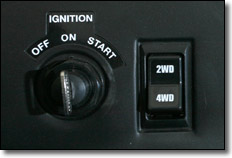 |
| The
Teryx 750 FI Sport features Cast Aluminum
wheels, which are 2.2lbs lighter than
steel each, and the sport model also has
fully adjustable front & rear suspension
with 7.5" of wheel travel |
Kawasaki’s V-twin digital fuel injection
engine provides plenty of smooth continuous
power, with instant acceleration and plenty
of torque, while the wide body frame construction
and long travel independent suspension provides
plenty of stability and easy handling. The Kawasaki
Teryx also comes equipped with Maxxis tires
and offers 11.7 inches of ground clearance.
While the standard Teryx 750 FI 4x4 models
come well equipped, the Sport model has a couple
of features that make it stand out from the
crowd, such as the fully adjustable front and
rear suspension (that would come in very handy
on our test ride), cast aluminum wheels, and
special colors and graphics.
We traveled to Boulders OHV Park to put the Kawasaki
Teryx 750 FI 4x4 to the test. When we arrived,
we were pleasantly surprised to find out that
we would be testing out the Sport model, which
is the only Teryx model equipped with adjustable
shocks, and were excited to check out all the
improvements to the ’09 line up first hand.
|
|
|
2009
Kawasaki Teryx 750 FI 4x4 Sport Edition
RUV Test Units |
Kawasaki had an 18 mile loop section of trails
picked out for us to test the 2009 Teryx 750
FI that featured plenty of varied terrain to
check out the UTV’s capabilities. Our
first time through the loop, we hit a sandy
whoop section and we thought the factory suspension
settings seemed to feel a little stiff, so we
had the Kawasaki crew adjust them a little bit
and it certainly made a difference, especially
in the rougher stuff. We were able to fly through
the whoops. “The shocks are really tunable.
After we had them adjusted it made a huge difference,”
said Kevin Johnston, who was along for the ride.
The Teryx felt really stable in the corners
with is wide frame, and there was minimum body
roll.
The power on the Teryx was very good. “The
power was right there when we needed it and
the throttle response was right on with no delay.
We were able to go over rocks and other obstacles
with no problems and climb steep hills with
ease,” said Johnston. The EFI delivered
smooth consistent power and was very responsive
when you hit the throttle. We did find however,
that the Teryx is a lot more fun to drive in
low gear on tighter trails and more technical
terrain as there is a lot more torque than when
in high gear, which we thought was fine for
wide open high speed riding. In high gear, the
top speed of the 2009 Teryx 750 FI 4x4 Sport
was 47 MPH, which was a slight improvement over
when we tested the ’08 model, which had
a top speed of 46 MPH. In low gear the machine
hits the rev limiter at 35, which is quite satisfactory
for the conditions low gear would be used for.
The braking on the Teryx 750 FI 4x4 Sport was
excellent, just as it was in the ’08 models.
This machine can stop on a dime if needed.
| |
|
| The
2008 Test Ride allowed us to really test
out the rock crawling ability of the Teryx,
but we were able to find a small rocky
section at the Arizona location, which
allowed us to test out the dff-lock and
the ground clearance of the Teryx, and
it once again performed great especially
in low range |
 |
| 2WD
& 4WD switch is easy to access on
the dash, but the vehicle must be going
slower than 16Mph without any wheel spin
to engage the 4WD on the fly |
We tested out both the 2WD and 4WD as well and
while the steering is good in either mode, it
seems just a little bit more responsive when it
is in 4WD. The differential lock came in handy
for us out on the trails as well when we got stuck
in a big rocky section. Much to our delight, the
differential lock was very easy to engage and
worked like a charm. We were able to crawl right
out of the rocks without any problems.
When we tested the ’08 Teryx, we had
noticed that there wasn’t much heat protection
from the motor and that the passenger and driver’s
seats got a little hot on longer rides. We were
happy to see that Kawasaki has taken measures
to help reduce the heat by adding rubber shrouds
to help insulate the cockpit a little better.
While this cut down the heat dramatically on
the passenger side, we noticed that the driver’s
seat still got a little warm, but not uncomfortably
so like in the ’08 models.














